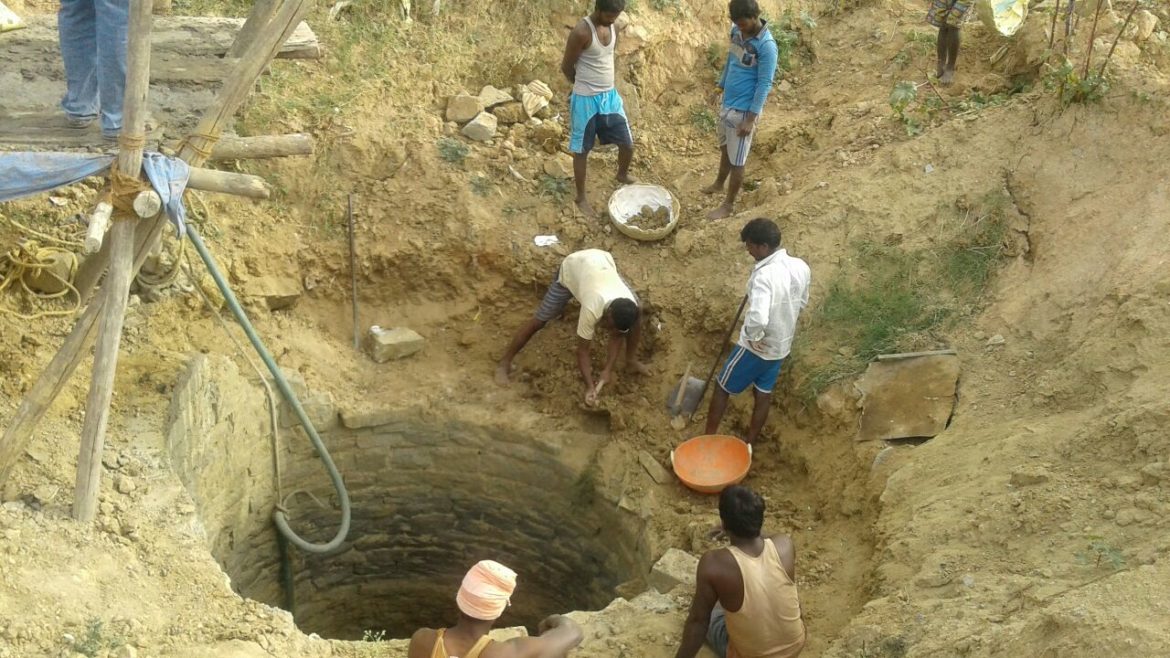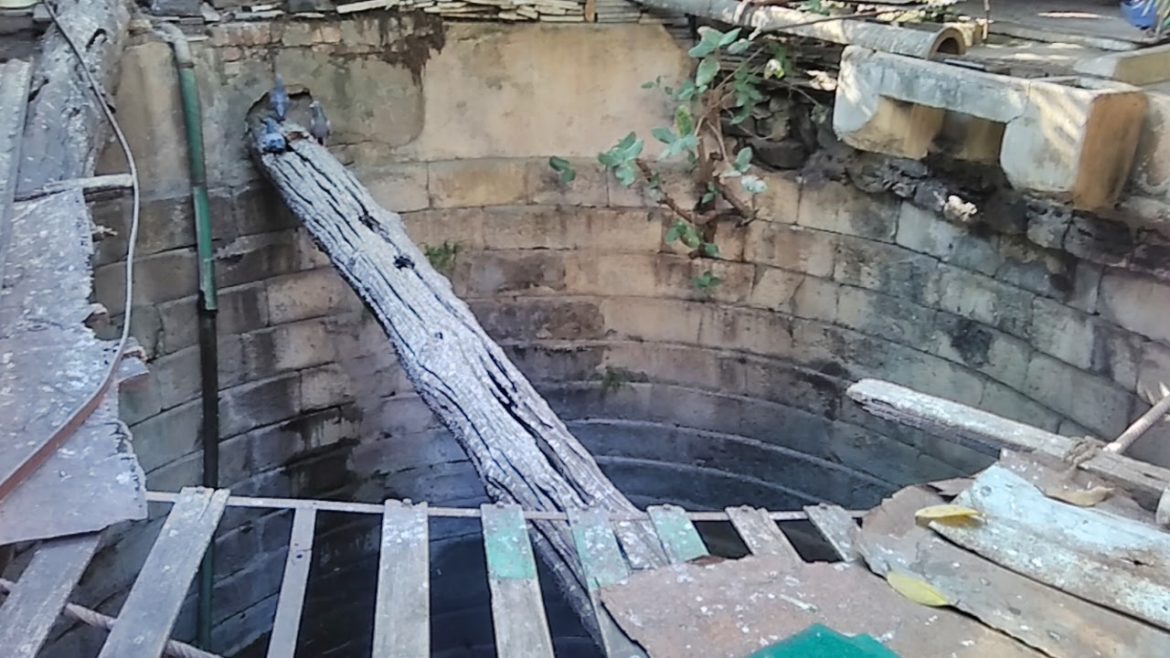Over the past 10 years I have been working with BIOME Environmental, an organization that looks at ways to promote sustainable living in a city – not only in theory but also in practice. The practice comes from the solutions that the group of BIOME engineers and architects offer – homes designed to keep energy requirements low, homes made of sun-dried mud blocks, homes which store and reuse rainwater, homes that treat wastewater and allow it to be reused within the site itself, etc.. I am a part of the Water team within BIOME, and this allows me the opportunity to travel and look at various aspects of water – the issues and solutions – around Bangalore and across the country. The water sources that capture my imagination and that of my team– for their beauty, human ingenuity, history, adventure and poetry – are not the springs, rivers, dams and lakes, but simple manmade structures that provide access to water – shallow open wells.
The ability to dig into the ground and find water was probably one of the initial eureka moments for mankind. This allowed people to live away from the rivers, get away from the tyranny of flood and drought, while still having access to water. The invention of the well possibly over time led to the inventions of the pulley, Persian wheels , motors, solar pumps and so on.
Open Wells across the continent range from 10 feet to about 80 feet in depth. The water level rises and falls with the seasons, and provides us a window into the earth’s insides, speaking to us about the water that is available. The dug well is normally lined with some strong material so as to keep the walls from caving in. Older wells are normally lined with stones which are easily available in the area, and hence tell you about the geology of the place. Nowadays most wells are lined with cement rings and that makes the well lose a bit of character- for by looking at the lining you can’t guess which part of the country the well is in! While some wells are plain jane in how they look, there are those like the Rani-ki-Vav in Patan, Gujarat that have been built with love, hard work and exquisite skill. While some of the wells still have water and have been retained in all their glory, many are now decrepit, abandoned and used as dumps (like the well in Qutb Minar that is dry and is used as a dump for used drinking water bottles) . Many wells have also been filled up and closed forever for fear of little children falling in. Each old open well you see tells you a story of not only the water around it, but the people, their behaviours, their fears and worries and natural events around the well. This write-up is largely about my (re)discovery of ground water in places that I have lived in for extended periods of time, and in almost all cases discovered the open wells only much later.
The water sources that capture my imagination and that of my team– for their beauty, human ingenuity, history, adventure and poetry – are not the springs, rivers, dams and lakes, but simple manmade structures that provide access to water – shallow open wells.
Jamshedpur Wells

I grew up in Jamshedpur, but it was a work trip to Jamshedpur after very many years that got me wondering about the groundwater there. Jamshedpur is a well-managed steel township surrounded by the rivers Swarnarekha and Kharkhai, and domestic water demand is met by dams on the river. Most of my school friends and older associates whom I met on the trip did not know of open wells. A little asking around took me to temples where the open wells have been preserved. The wells are 5 -10 feet in diameter and 30-40 feet deep and water is available at 10-20 feet below ground level in winter. The wells have been retained since it is required that the priest bathe in well water before performing any rituals. However some deeper questioning reveals that well water is of good quality and is also used as drinking water in the neighbourhood. I am even given a glass of water to drink.
In the outskirts of the city more wells abound. These are not ring wells but stone lined wells. The variously coloured stones lining the well reveal the diverse mineral richness in the area. It is amazing to see how the shallow aquifer fluctuates in this region. While water is available at 20-25 feet in some places, in some others it is not available even at 250 feet. Well water is used only for non potable purposes. The people go into city limits to fetch drinking water, They, however, do tell me that they used to drink this well water till not long ago, and somehow somewhere along the way that practice stopped. They are all digging deeper borewells now. The borewells are seen as more perennial sources of water even though the open wells dry up only for about 2-4 weeks in summer.
Each old open well you see tells you a story of not only the water around it, but the people, their behaviours, their fears and worries and natural events around the well.
Bombay Wells

Four years in college and numerous walks around Powai lake and Vihar lake, and access to water almost always at the turning of the tap, never led one to think of sources of water other than the lakes. Turns outIwas not the only one who did not know about groundwater; many other Bombayites didn’t either. With a meeting getting over at Dadar a little ahead of time, and the flight to Bangalore a little late at night, I decided to go looking for open wells. A senior hydrogeologist who I had met at the meeting and who had grown up in Mumbai asked me to go the Prabhadevi temple not far from Dadar. The clues started appearing as I neared the temple – there were many water tankers plying and some conversations helped me figure out that they were supplying water from nearby open wells. The well behind the temple turned out to be inaccessible. With some asking around I came upon this really beautiful open well in a quaint old home, which seemed outworldly in the otherwise modern and high rise city. Manoj showed me around. His father owns the house and the well. By Manoj’s estimates the well is more than 100 years old. All year round fresh “meetha” (not “Khara”) water flows into the well. You can very clearly see the inflows. There are some fishes that breed in the well. There are other wells in the area he tells me, but many people have either closed them or put concrete slabs on top. Manoj thinks a well needs to breathe and hence does not want to cover it. He is not worried that kids may fall in – their entire family has grown up around the well and no kid has fallen in till date, he says. Manoj also directs me to the open well in Shivaji Park, which I am unable to get to for lack of time. And that I store away in my to-do list for another Bombay trip. Just this small detour to Prabhadevi makes the trip to Bombay seem even more delightful. The engineer in me leaves me thinking about where the recharge zone for these wells may be
Adoor Wells

My parents live in Adoor, Kerala. About two weeks of every summer vacation get spent here. Open wells in each home are the default. It is their only source of water, and hence it is in each home owners interest to keep their wells clean and full. It’s only now that the town administration is starting to supply piped water. It’s lovely to see the style of wells here, it is more matter-of-fact, with no frills – there are no cement rings, no stones, the rocks is hewn to create the structure of the well. Summer holidays also come with pre-monsoon showers. After a few consecutive showers you can see the well water level increase. Well water is used all year round. Conversation between neighbours is often about the water level in the well, motors and so on. Based on the water level in the well, the water requirements of the household are managed.
Bangalore Wells
Bangalore is where I live and work. Water requirements of the city are met from the river Cauvery that flows almost 100 kms away from the city. However, 50%-60% of the water requirement is actually said to be met from groundwater, via deep borewells of up to 1700 feet.
At the same time, open wells have been a traditional source of water. Many of these wells still exist, many new ones are being dug, and many old ones are being rejuvenated as pockets of shallow aquifers are rediscovered locally. There still are communities of traditional open well diggers (from the Manu Vaddar community), living in the peripheries of the city and helping in the creation of this ancient water infrastructure. In Bangalore, the well is a coping mechanism to compensate for the inability of the city administration to provide drinking water. Communities have come together to clean and revive their open wells.
From the Indus Valley civilisation to Ashoka’s times and till date, shallow open wells have been dug across the landscape of the country. In the current age of FB a fairly vibrant group on Facebook helps documents the “Open Wells of India and the World”.
From the Indus Valley civilisation to Ashoka’s times and till date, shallow open wells have been dug across the landscape of the country.
While wells are obviously a source of water for all that we need water for, a well can also be a source of fun and adventure. On my bucket list would be to swim in a deep well on a hot summer day, uncertain of the depth of the well, to not have any security/grab rails to hold on to at the perimeter of the wells, to look around and see the walls of the well and to look up and see only the sky. That for me would be quite an experience.
And if some of you are wondering what is the big deal about open wells (as I did till about 10 years ago and my kids do now), do look at the Open Well 101 that has been developed with a lot of love and patience.
[PS: While most pictures are mine, I have taken the liberty to use some delightful ones from friends and colleagues (who I know will be happy I used them and didn’t ask for permission). Many thanks to them.]




